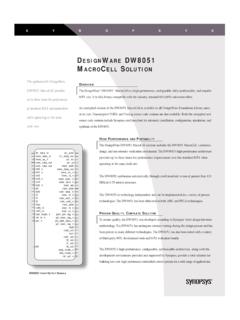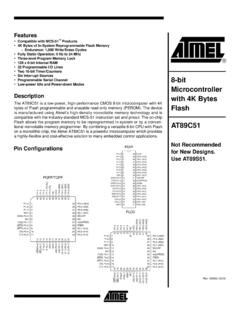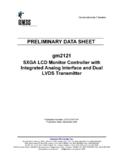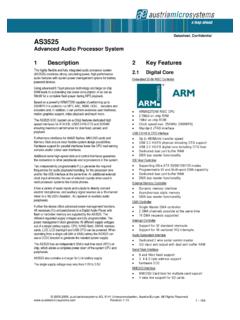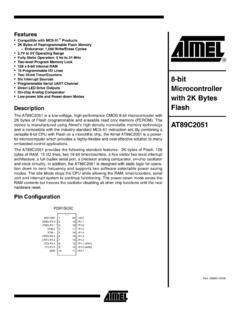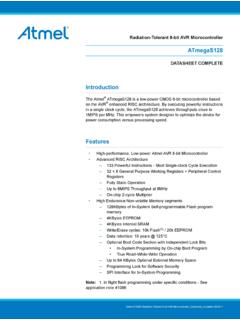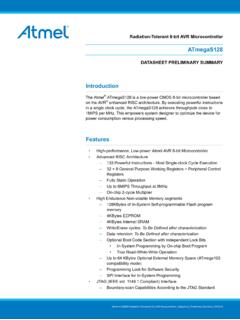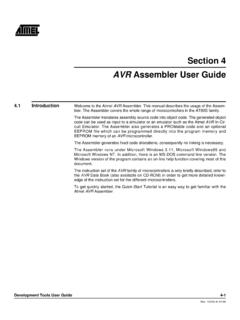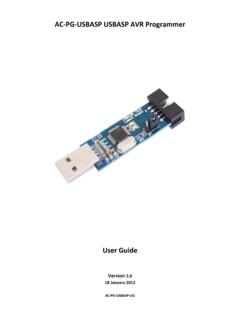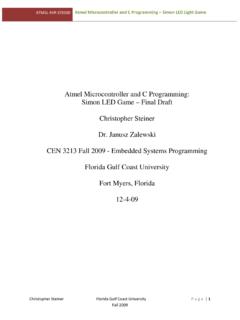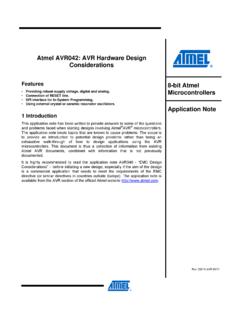Transcription of 8-bit Microcontroller with 4K Bytes In-System …
1 1 Features Compatible with MCS-51 Products 4K Bytes of In-System Programmable (ISP) Flash Memory Endurance: 1000 Write/Erase Cycles to Operating Range Fully Static Operation: 0 Hz to 33 MHz Three-level Program Memory Lock 128 x 8-bit Internal RAM 32 Programmable I/O Lines Two 16-bit Timer/Counters Six Interrupt Sources Full Duplex UART Serial Channel Low-power Idle and Power-down Modes Interrupt Recovery from Power-down Mode Watchdog Timer Dual Data Pointer Power-off Flag Fast Programming Time Flexible ISP Programming (Byte and Page Mode)DescriptionThe AT89S51 is a low-power, high-performance CMOS 8-bit Microcontroller with 4 Kbytes of In-System programmable Flash memory. The device is manufactured usingAtmel s high-density nonvolatile memory technology and is compatible with the indus-try-standard 80C51 instruction set and pinout. The on-chip Flash allows the programmemory to be reprogrammed In-System or by a conventional nonvolatile memory pro-grammer.
2 By combining a versatile 8-bit CPU with In-System programmable Flash on amonolithic chip, the atmel AT89S51 is a powerful Microcontroller which provides ahighly-flexible and cost-effective solution to many embedded control AT89S51 provides the following standard features: 4K Bytes of Flash, 128 Bytes ofRAM, 32 I/O lines, Watchdog timer, two data pointers, two 16-bit timer/counters, a five-vector two-level interrupt architecture, a full duplex serial port, on-chip oscillator, andclock circuitry. In addition, the AT89S51 is designed with static logic for operationdown to zero frequency and supports two software selectable power saving Idle Mode stops the CPU while allowing the RAM, timer/counters, serial port, andinterrupt system to continue functioning. The Power-down mode saves the RAM con-tents but freezes the oscillator, disabling all other chip functions until the next externalinterrupt or hardware Microcontroller with 4K Bytes In-System Programmable FlashAT 8 9 S 5 1 Rev.
3 2487A 10/012 AT89S512487A 10/01 Pin ConfigurationsPDIPTQFP123456789101112131 4151617181920403938373635343332313029282 7262524232221 (MOSI) (MISO) (SCK) (RXD) (TXD) (INT0) (INT1) (T0) (T1) (WR) (RD) (AD0) (AD1) (AD2) (AD3) (AD4) (AD5) (AD6) (AD7)EA/ (A15) (A14) (A13) (A12) (A11) (A10) (A9) (A8)123456789101133323130292827262524234 4434241403938373635341213141516171819202 122(MOSI) (MISO) (SCK) (RXD) (TXD) (INT0) (INT1) (T0) (T1) (AD4) (AD5) (AD6) (AD7)EA/ (A15) (A14) (A13) (AD0) (AD1) (AD2) (AD3)(WR) (RD) (A8) (A9) (A10) (A11) (A12) (MOSI) (MISO) (SCK) (RXD) (TXD) (INT0) (INT1) (T0) (T1) (AD4) (AD5) (AD6) (AD7)EA/ (A15) (A14) (A13)65432144434241401819202122232425262 728(WR) (RD) (A8) (A9) (A10) (A11) (A12) (AD0) (AD1) (AD2) (AD3)3 AT89S512487A 10/01 Block DiagramPORT 2 DRIVERSPORT - 0 LATCHRAMPROGRAMADDRESSREGISTERBUFFERPCIN CREMENTERPROGRAMCOUNTERDUAL DPTRINSTRUCTIONREGISTERBREGISTERINTERRUP T, SERIAL PORT,AND TIMER BLOCKSSTACKPOINTERACCTMP2 TMP1 ALUPSWTIMINGANDCONTROLPORT 1 - 3 LATCHPORT 3 - / 0 - 1 LATCHWATCHDOGISPPORTPROGRAMLOGIC4 AT89S512487A 10/01 Pin DescriptionVCCS upply 0 Port 0 is an 8-bit open drain bidirectional I/O port.
4 As an output port, each pin can sink eightTTL inputs. When 1s are written to port 0 pins, the pins can be used as high-impedanceinputs. Port 0 can also be configured to be the multiplexed low-order address/data bus duringaccesses to external program and data memory. In this mode, P0 has internal 0 also receives the code Bytes during Flash programming and outputs the code bytesduring program verification. External pull-ups are required during program verification. Port 1 Port 1 is an 8-bit bidirectional I/O port with internal pull-ups. The Port 1 output buffers cansink/source four TTL inputs. When 1s are written to Port 1 pins, they are pulled high by theinternal pull-ups and can be used as inputs. As inputs, Port 1 pins that are externally beingpulled low will source current (IIL) because of the internal pull-ups. Port 1 also receives the low-order address Bytes during Flash programming and 2 Port 2 is an 8-bit bidirectional I/O port with internal pull-ups.
5 The Port 2 output buffers cansink/source four TTL inputs. When 1s are written to Port 2 pins, they are pulled high by theinternal pull-ups and can be used as inputs. As inputs, Port 2 pins that are externally beingpulled low will source current (IIL) because of the internal 2 emits the high-order address byte during fetches from external program memory andduring accesses to external data memory that use 16-bit addresses (MOVX @ DPTR). In thisapplication, Port 2 uses strong internal pull-ups when emitting 1s. During accesses to externaldata memory that use 8-bit addresses (MOVX @ RI), Port 2 emits the contents of the P2 Spe-cial Function 2 also receives the high-order address bits and some control signals during Flash pro-gramming and 3 Port 3 is an 8-bit bidirectional I/O port with internal pull-ups. The Port 3 output buffers cansink/source four TTL inputs. When 1s are written to Port 3 pins, they are pulled high by theinternal pull-ups and can be used as inputs.
6 As inputs, Port 3 pins that are externally beingpulled low will source current (IIL) because of the 3 receives some control signals for Flash programming and 3 also serves the functions of various special features of the AT89S51, as shown in thefollowing PinAlternate (used for In-System Programming) (used for In-System Programming) (used for In-System Programming)5 AT89S512487A 10/01 RSTR eset input. A high on this pin for two machine cycles while the oscillator is running resets thedevice. This pin drives High for 98 oscillator periods after the Watchdog times out. The DIS-RTO bit in SFR AUXR (address 8EH) can be used to disable this feature. In the default stateof bit DISRTO, the RESET HIGH out feature is Latch Enable (ALE) is an output pulse for latching the low byte of the address duringaccesses to external memory. This pin is also the program pulse input (PROG) during Flashprogramming.
7 In normal operation, ALE is emitted at a constant rate of 1/6 the oscillator frequency and maybe used for external timing or clocking purposes. Note, however, that one ALE pulse isskipped during each access to external data memory. If desired, ALE operation can be disabled by setting bit 0 of SFR location 8EH. With the bit set,ALE is active only during a MOVX or MOVC instruction. Otherwise, the pin is weakly pulledhigh. Setting the ALE-disable bit has no effect if the Microcontroller is in external Store Enable (PSEN) is the read strobe to external program memory. When the AT89S51 is executing code from external program memory, PSEN is activatedtwice each machine cycle, except that two PSEN activations are skipped during each accessto external data memory. EA/VPPE xternal Access Enable. EA must be strapped to GND in order to enable the device to fetchcode from external program memory locations starting at 0000H up to FFFFH.
8 Note, however,that if lock bit 1 is programmed, EA will be internally latched on reset. EA should be strapped to VCC for internal program pin also receives the 12-volt programming enable voltage (VPP) during to the inverting oscillator amplifier and input to the internal clock operating from the inverting oscillator amplifierPort PinAlternate (serial input port) (serial output port) (external interrupt 0) (external interrupt 1) (timer 0 external input) (timer 1 external input) (external data memory write strobe) (external data memory read strobe)6 AT89S512487A 10/01 Special Function RegistersA map of the on-chip memory area called the Special Function Register (SFR) space is shownin Table that not all of the addresses are occupied, and unoccupied addresses may not be imple-mented on the chip. Read accesses to these addresses will in general return random data,and write accesses will have an indeterminate 1.
9 AT89S51 SFR Map and Reset Values0F8H0 FFH0F0HB000000000F7H0E8H0 EFH0E0 HACC000000000E7H0D8H0 DFH0D0 HPSW000000000D7H0C8H0 CFH0C0H0C7H0B8 HIPXX0000000 BFH0B0HP3111111110B7H0A8 HIE0X0000000 AFH0A0HP211111111 AUXR1 XXXXXXX0 WDTRSTXXXXXXXX0A7H98 HSCON00000000 SBUFXXXXXXXX9FH90HP11111111197H88 HTCON00000000 TMOD00000000TL000000000TL100000000TH0000 00000TH100000000 AUXRXXX00XX08FH80HP011111111SP00000111DP 0L00000000DP0H00000000DP1L00000000DP1H00 000000 PCON0 XXX000087H7 AT89S512487A 10/01 User software should not write 1s to these unlisted locations, since they may be used in futureproducts to invoke new features. In that case, the reset or inactive values of the new bits willalways be Registers: The individual interrupt enable bits are in the IE register. Two prioritiescan be set for each of the five interrupt sources in the IP Data Pointer Registers: To facilitate accessing both internal and external data memory,two banks of 16-bit Data Pointer Registers are provided: DP0 at SFR address locations 82H-83H and DP1 at 84H-85H.
10 Bit DPS = 0 in SFR AUXR1 selects DP0 and DPS = 1 selects user should always initialize the DPS bit to the appropriate value before accessing therespective Data Pointer 2. AUXR: Auxiliary RegisterAUXRA ddress = 8 EHReset Value = XXX00XX0 BNot Bit Addressable WDIDLEDISRTO DISALEBit 765 432 10 Reserved for future expansionDISALED isable/Enable ALEDISALEO perating Mode0 ALE is emitted at a constant rate of 1/6 the oscillator frequency1 ALE is active only during a MOVX or MOVC instructionDISRTOD isable/Enable Reset outDISRTO0 Reset pin is driven High after WDT times out1 Reset pin is input onlyWDIDLED isable/Enable WDT in IDLE modeWDIDLE0 WDT continues to count in IDLE mode1 WDT halts counting in IDLE mode8 AT89S512487A 10/01 Power Off Flag: The Power Off Flag (POF) is located at bit 4 ( ) in the PCON is set to 1 during power up. It can be set and rest under software control and is notaffected by OrganizationMCS-51 devices have a separate address space for Program and Data Memory.


